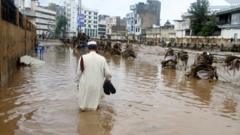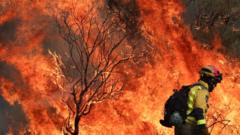Northern Spain's El Granado has recorded a staggering 46°C, marking a potential record for June and raising concerns over heat-related health emergencies.
**Europe Faces Historic Heatwave, Spain Sets June Record with 46°C**

**Europe Faces Historic Heatwave, Spain Sets June Record with 46°C**
A relentless heatwave is sweeping through Europe, with extreme temperatures prompting health warnings across multiple nations.
Europe is currently enduring an intense heatwave, with significant records being broken as temperatures soar across the continent. Spain has been particularly hard-hit, as authorities report that the town of El Granado experienced a blistering 46°C on Saturday, setting a new high for June and potentially making this month the hottest on record.
In response to the rising temperatures, red heat warnings have been issued in several regions, including parts of Portugal, Italy, and Croatia, while amber alerts cover a wider swath of areas across Spain, France, Austria, Belgium, and more. The situation has taken a tragic turn in Barcelona, where a road sweeper reportedly died after a shift during sweltering conditions, prompting an investigation by local authorities.
Health impacts are being felt throughout Europe, as hospitals are overwhelmed with heatstroke cases. In Italy, emergency departments noted an increase in patients, specifically among vulnerable populations like the elderly and those without homes. To address this crisis, some cities, such as Bologna and Rome, have established climate shelters and provided access to cooling facilities, reflecting the urgent need to protect those at risk.
In neighboring countries, Serbia recorded its highest temperature since the 19th century, and Slovenia saw a record June high, with North Macedonia hitting 42°C. In Lisbon, local pharmacists have been advising residents to stay indoors during peak temperature hours, as cases of heat-related illness have begun to emerge.
The forecast suggests that the heatwave will extend into the upcoming week, spreading further across France, Germany, and the UK, with potential temperature spikes in London. A large area of high-pressure is largely responsible for this relentless heat, as descending dry air continues to warm the atmosphere.
While attributing individual extreme weather events to climate change can be complex, the science clearly shows that such heatwaves are becoming more frequent and severe. Researchers indicate that the likelihood of experiencing a June heatwave with three consecutive days above 28°C is ten times greater today than during pre-industrial times, highlighting an urgent call to address climate change.
In response to the rising temperatures, red heat warnings have been issued in several regions, including parts of Portugal, Italy, and Croatia, while amber alerts cover a wider swath of areas across Spain, France, Austria, Belgium, and more. The situation has taken a tragic turn in Barcelona, where a road sweeper reportedly died after a shift during sweltering conditions, prompting an investigation by local authorities.
Health impacts are being felt throughout Europe, as hospitals are overwhelmed with heatstroke cases. In Italy, emergency departments noted an increase in patients, specifically among vulnerable populations like the elderly and those without homes. To address this crisis, some cities, such as Bologna and Rome, have established climate shelters and provided access to cooling facilities, reflecting the urgent need to protect those at risk.
In neighboring countries, Serbia recorded its highest temperature since the 19th century, and Slovenia saw a record June high, with North Macedonia hitting 42°C. In Lisbon, local pharmacists have been advising residents to stay indoors during peak temperature hours, as cases of heat-related illness have begun to emerge.
The forecast suggests that the heatwave will extend into the upcoming week, spreading further across France, Germany, and the UK, with potential temperature spikes in London. A large area of high-pressure is largely responsible for this relentless heat, as descending dry air continues to warm the atmosphere.
While attributing individual extreme weather events to climate change can be complex, the science clearly shows that such heatwaves are becoming more frequent and severe. Researchers indicate that the likelihood of experiencing a June heatwave with three consecutive days above 28°C is ten times greater today than during pre-industrial times, highlighting an urgent call to address climate change.


















